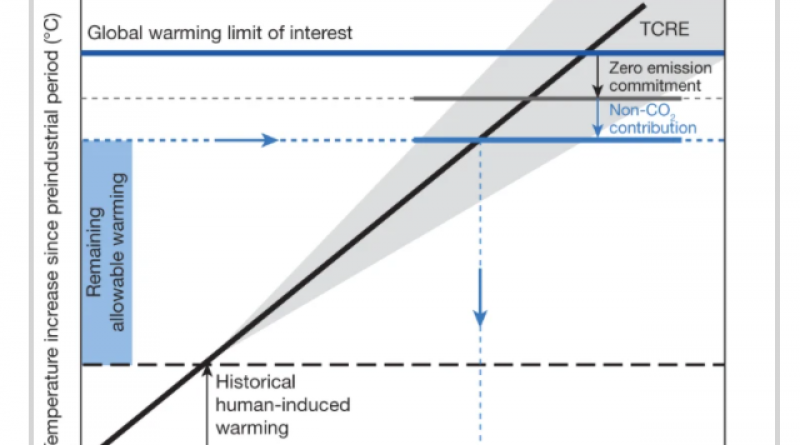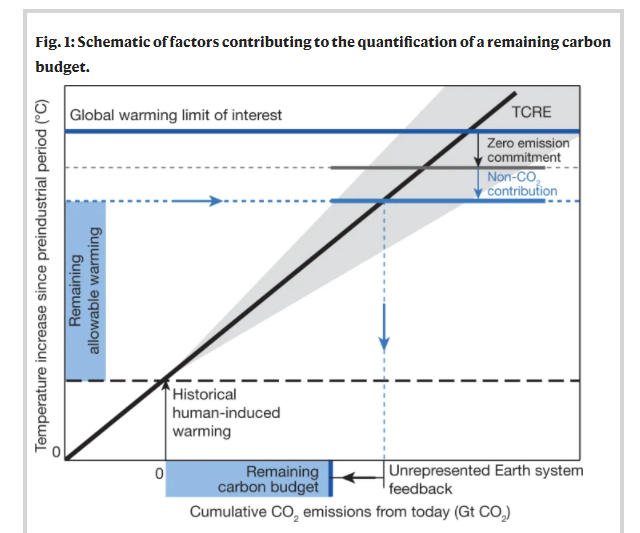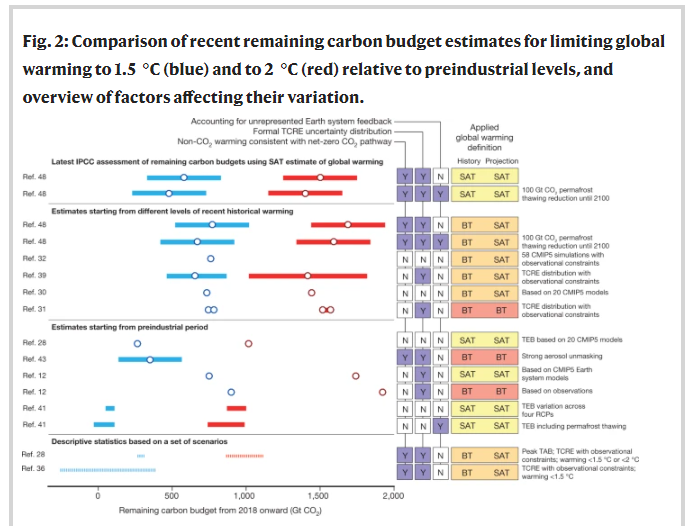Estimating and tracking the remaining carbon budget for stringent climate targets.

Abstract
Research reported during the past decade has shown that global warming is roughly proportional to the total amount of carbon dioxide released into the atmosphere. This makes it possible to estimate the remaining carbon budget: the total amount of anthropogenic carbon dioxide that can still be emitted into the atmosphere while holding the global average temperature increase to the limit set by the Paris Agreement. However, a wide range of estimates for the remaining carbon budget has been reported, reducing the effectiveness of the remaining carbon budget as a means of setting emission reduction targets that are consistent with the Paris Agreement. Here we present a framework that enables us to track estimates of the remaining carbon budget and to understand how these estimates can improve over time as scientific knowledge advances. We propose that application of this framework may help to reconcile differences between estimates of the remaining carbon budget and may provide a basis for reducing uncertainty in the range of future estimates.
Main
Since the Fifth Assessment Report of the Intergovernmental Panel on Climate Change (IPCC)1, the concept of a carbon budget has risen to prominence as a tool in guiding climate policy2. We here define the remaining carbon budget as the finite total amount of CO2 that can be emitted into the atmosphere by human activities while still holding global warming to a desired temperature limit. This is not to be confused with another concept, the historical carbon budget, which describes estimates of all major past and contemporary carbon fluxes in the Earth system3. The idea of a remaining carbon budget is grounded in well established climate science. A series of studies over the past decade has clarified and quantified why the rise in global average temperature increase is roughly proportional to the total cumulative amount of CO2 emissions produced by human activities since the industrial revolution4,5,6,7,8,9,10,11,12,13. This literature has allowed scientists to define the linear relationship between warming and cumulative CO2 emissions as the transient climate response to cumulative emissions of CO2 (TCRE). Once established, the appeal of this concept became immediately evident: the possibility that the response of an enormously complex system—such as the response of planet Earth to our emissions of CO2—could potentially be reduced to a roughly linear relationship would allow scientists to infer clear and easy-to-communicate implications. However, additional processes that influence and are influenced by future warming, such as the thawing of permafrost, have recently been included in models that simulate the Earth system. These additional processes add uncertainty and may change our understanding of this linear relationship. Moreover, global warming is not driven by emissions of CO2 only. Other greenhouse gases (such as methane, fluorinated gases or nitrous oxide) and aerosols and their precursors (including soot or sulphur dioxide) affect global temperatures. Estimating the remaining carbon budget thus also implies making assumptions about these non-CO2 contributions. This further complicates the relationship between future CO2 emissions and global warming.
Carbon budgets nevertheless have become a powerful tool for communicating the challenges we face in aiming to hold warming to 1.5 °C and to well below 2 °C—the limits of global average temperature increase set out in the United Nations Paris Agreement14,15,16,17,18. First, every tonne of CO2 emitted into the atmosphere by human activities adds to warming, and it does not matter whether this tonne of CO2 is emitted today, tomorrow or yesterday. This also implies that to limit temperature increase to any level, global CO2 emissions produced by human activities must be reduced to net-zero levels at some point in time and, on average, stay at net-zero levels thereafter. Furthermore, when aiming to limit warming to below a specific limit, a finite carbon budget also implies that the more we emit in the coming years, the faster emissions will have to decline thereafter to stay within the same budget—simple arithmetic. Finally, once net CO2 emissions are brought to zero, warming would stabilize but would not disappear or be reversed19,20,21. Any amount by which a carbon budget compatible with a desired temperature limit is missed or exceeded would thus have to be actively and permanently removed from the atmosphere in later years. This could be achieved through measures that result in net negative CO2 emissions, which come with their own technical and social complications22,23,24,25,26,27. Besides its role as a communication tool, the carbon budget concept also provides a way to exchange knowledge across disciplines. For example, such knowledge exchange is already happening for climate change mitigation requirements between the geoscience community and other disciplines that study climate change from a more societal angle28,29.
Diversity that may confuse
Unfortunately, all that glitters is not gold. Over the past five years, a plethora of studies have been published12,30,31,32,33,34,35,36,37,38,39,40,41,42,43,44 further exploring and estimating the size of carbon budgets while in some way accounting for non-CO2 climate forcing. These studies most often focus on requirements for holding warming to the internationally agreed 1.5 °C or 2 °C limits14,15,16. Although all studies aim to evaluate the same quantity, the use of different definitions and non-CO2 climate forcing assumptions, as well as methodological and model differences, have led to a wide variety of reported carbon budget estimates that aim to achieve temperature goals that are nominally the same (see Box 1 for an overview of carbon budget estimation approaches). This variation seems to have decreased instead of increased the broader understanding of the remaining carbon budget and has thus tempered the initial enthusiasm about its usefulness as a guide for policy making and target setting45,46. This confusion is avoidable, however. Differences in remaining carbon budget estimates can be understood if a set of potential contributing factors are carefully taken into account.
Here we present a conceptual framework that allows one to track, understand, update and explain estimates of the remaining carbon budget over time. The framework’s structure enables the assessment of individual contributing factors, including historical warming, the TCRE, the zero-emissions commitment and non-CO2 contributions to future warming. It integrates suggestions made in earlier literature12,47 and is a generalization and extension of the framework used in ref. 48.
Remaining carbon budget framework
As discussed, the remaining carbon budget can be defined as the remaining amount of CO2 emissions that can still be emitted while keeping the global average temperature increase due to human activities to below a specific temperature limit. The framework set out below applies to a situation in which one aims to limit peak (or maximum) warming and its associated impacts. It can, however, also be extended to apply to a situation where temperature rise has temporarily exceeded an intended temperature limit, often referred to as a temperature overshoot (see Supplementary Text 1).
We present in equation (1) an estimate of the remaining carbon budget (Blim) for a specific temperature change limit (Tlim) as a function of five terms that represent aspects of the geophysical and coupled human–environment system (equation (1): the historical human-induced warming to date (Thist), the non-CO2 contribution to future temperature rise (TnonCO2)(TnonCO2), the zero-emissions commitment (TZEC), the TCRE, and an adjustment term for sources of unrepresented Earth system feedback (EEsfb). These terms are visualized in Fig. 1 and are described and discussed in turn below.


Transient climate response to cumulative emissions
Arguably the most central term to estimating the remaining carbon budget is the TCRE (in units of °C per gigatonne of carbon dioxide (Gt CO2); see equation (1). In essence, the remaining carbon budget is estimated by multiplying the remaining allowable warming with the inverse of the TCRE, where the magnitude of the remaining allowable warming is the result of various contributions shown in Fig. 1 and discussed below. The TCRE can be estimated from several lines of evidence, including the observational record10,12,49,50,51, CO2-only simulations10 and multi-gas simulations12,31,49,50,51,52,53 with Earth system models of varying complexity. In its latest assessment54, the IPCC reported the TCRE to fall within the range of 0.2–0.7 °C per 1,000 Gt CO2 with a probability of at least 66%. TCRE, and hence the linear proportionality of warming to cumulative emissions of CO2, has also been found to be robust up to about 7,300 Gt CO2 of cumulative emissions54,55 and probably more56. This domain of application easily spans the range of carbon budgets consistent with warming limits of 1.5 °C and 2 °C.
Historical and maximum temperature increase
After TCRE, the combined remaining allowable warming (represented by Tlim − Thist − TnonCO2TnonCO2 − TZEC) is the next key determinant for estimating the remaining carbon budget. Its first term is the specific temperature limit of interest relative to preindustrial levels (Tlim, in units of °C), and its second term represents the historical human-induced warming (Thist, in units of °C); see equation (1). Thist is the amount of human-induced warming since preindustrial times until a more recent reference period, such as the 2006–2015 period.
The estimation of Thist is a central factor affecting the size of the remaining carbon budget, because it determines how far we currently are from policy-relevant temperature limits (1.5 °C or 2 °C). The assessment of Thist should adequately isolate the human-induced warming signal from the effects of natural forcing and variability57,58. The same is true for Tlim, and if Tlim is intended to represent an internationally agreed climate goal in line with the Paris Agreement it should do so by definition15. Two additional choices play an important role in determining or setting Thist and Tlim: the choice of the preindustrial reference period and the temperature metric for determining global average temperature increase. Neither the preindustrial reference period nor the specific warming metric are explicitly defined by the Paris Agreement and recent literature has explored the implications and interpretations of this ambiguity34,35,59.
The 1850–1900 period is often used as a proxy for preindustrial levels because observational temperature records stretch back to the beginning of that period60, and key scientific reports that fed into the Paris Agreement also used this proxy1,59,61,62 (see Supplementary Text 2 for more details). Other periods have been suggested63,64,65, but ultimately the crux lies in that Thist and Tlim should always be expressed relative to the same preindustrial reference period to avoid introducing erroneous changes to the remaining allowable warming and therewith the remaining carbon budget. Besides defining an appropriate preindustrial reference period, the choice of metric by which warming is estimated from that period is also important. Studies analysing climate model simulations or observational products can use different metrics to estimate global mean temperature change (see Supplementary Text 2). The impact of this metric choice has been highlighted recently with studies34,59 showing that this choice can result in variations in the estimated global warming of the order of 10% (Supplementary Fig. 1), leading to a potential variation in remaining carbon budget estimates of more than 400 billion tonnes of CO2 (ref. 59). The IPCC has typically specified carbon budgets based on global area-averaged change in surface air temperature48,66. Other studies, however, have used different metrics and at times have even changed metrics between observations and projections (Supplementary Table 1, Fig. 2). This limits the comparability of these budget estimates59—a situation this new framework attempts to avoid.
Non-CO2 contribution to future warming
Another term affecting the remaining allowable warming is the non-CO2 contribution to future global temperature rise (TnonCO2TnonCO2, in units of °C) (see equation (1) and Fig. 1). Current and future warming depends on both CO2-induced warming and warming due to non-CO2 forcing. Future non-CO2 warming might be considerable, given that reducing emissions of cooling sulphur dioxide causes warming67 and the knowledge that no obvious mitigation options have been identified that can completely eliminate several important sources of non-CO2 greenhouse gases68,69. To include TnonCO2TnonCO2 in the remaining carbon budget framework, the non-CO2 warming contribution between a recent reference period (for example, the same period as Thist) and a specific time in the future has to be estimated. We suggest that this non-CO2 contribution to future temperature rise should be estimated from scenarios with an internally consistent evolution of greenhouse gases and other climate forcers36,70,71,72,73,74 and at the moment at which global CO2 emissions reach net zero48. Estimating the non-CO2 warming contribution at that moment in time reflects a situation in which global cumulative emissions of CO2 are effectively capped and hence allows us to directly inform the question of how much CO2 can be emitted while keeping warming to a given temperature level. If non-CO2 warming were to be estimated at other moments in time, its usefulness for informing mitigation requirements would potentially be strongly reduced.
Besides the future evolution of non-CO2 emissions, the non-CO2 warming contribution also depends on estimates of the corresponding radiative forcing, including potential changes in surface albedo43. Non-CO2 forcing and warming can be estimated with the help of simple climate models43,75,76, inferred from more complex climate model runs77, or taken from the literature37,48. Importantly, non-CO2 emissions would continue to affect warming levels after the time when net CO2 reaches zero, which creates uncertainty in methods that estimate budgets by integrating changes over time and after an overshoot (for example, see refs 36,43 and Box 1). These uncertainties are reduced in the framework proposed in this Perspective by focusing on the time of reaching net-zero CO2 emissions and by considering internally consistent non-CO2 emissions. Under these assumptions, non-CO2 emissions are projected to result in a constant or declining forcing and warming after the time of net-zero CO2 (refs 48,73). However, if under alternative assumptions one would project non-CO2 warming to continue to increase irrespective of the level of CO2 emissions78, this further increase should also be accounted for within TnonCO2TnonCO2 because it would add to future peak warming.
Zero-emissions commitment
The zero-emissions commitment, TZEC (in units of °C) is the next term in the remaining carbon budget framework represented by equation (1). TZEC is defined as the additional contribution to peak warming that is still to be expected after a complete cessation of CO2 emissions79,80, and hence provides a correction term for the instantaneous linearity postulated by the concept of the TCRE. TZEC can be positive, negative or zero. For estimates of the remaining carbon budget, the TZEC when CO2 emissions approach net-zero levels is of particular interest. In more general terms, this could also be formulated as an assessment of the lag in CO2-induced warming at current and declining emissions rates50,79. When TZEC is positive, not all warming will have been experienced by the time global CO2 emissions reach net zero. The estimated additional warming would hence also have to be reduced from the allowable remaining temperature increase. At present, TZEC is frequently neglected in carbon budget studies (see Supplementary Table 1, with exceptions only hypothesizing the effect of its contribution37) and is hence implicitly assumed to be zero or negative. Several studies suggest, however, that there might be a smaller79,80,81,82 or larger83,84 lag between the time when CO2 emissions have ceased and the time of maximum warming caused by those emissions. Instead of being accounted for as a separate term, the TZEC could also be integrated within the assessment of TCRE, although a dedicated methodological framework to do so is currently lacking.
Unrepresented sources of Earth system feedback
Finally, reductions in emissions due to unrepresented Earth system feedback mechanisms (EEsfb, in units of Gt CO2), are the last term in the proposed remaining carbon budget framework (equation (1)). Any Earth system feedback that is not yet incorporated in estimates of the TCRE or that would reduce the applicability of TCRE should be assessed, and accounted for and communicated as part of EEsfb. These feedback processes have typically been related to permafrost thawing40,41,42,85 and the associated long-term release of CO2 and CH4. However, other Earth system feedback sources that can affect remaining carbon budgets have been identified42, including changes in vegetation CO2 uptake linked to nitrogen availability86,87,88. If unrepresented feedback results in a direct CO2 emission from an ecosystem, the translation to the EEsfb term is direct. However, because of the diverse nature of Earth system feedback42, accounting for it through an adjustment in CO2 emissions is not always straightforward. For example, if a feedback system results in the release of other greenhouse gases or affects the Earth system through changes in surface albedo, clouds or fire regimes, for example, its contribution needs to be translated into an equivalent CO2 correction term (see refs 89,90 for example). Because most Earth system feedback is either sensitive to rising CO2 or to variations in climate parameters, it is expected that these contributions are scenario-dependent, nonlinear, and in some cases realized over longer timescales only40,41,85,91,92,93,94,95,96,97,98. This adds to the complexity of the translation into a CO2-equivalent correction term, and makes EEsfb an uncertain contribution. EEsfb could be estimated either for the time at which global net CO2 emissions become zero or until the end of the century or beyond, assuming anthropogenic CO2 emissions are kept at net-zero levels but feedback mechanisms continue to change over time41,85,92,93,97. Finally, scenario-independent Earth system feedback that scales linearly with global average temperature increase could also be incorporated by adjusting the TCRE, as long as it is not double-counted in both EEsfb and TCRE.
Non-CO2 contribution to future warming
Another term affecting the remaining allowable warming is the non-CO2 contribution to future global temperature rise (TnonCO2TnonCO2, in units of °C) (see equation (1) and Fig. 1). Current and future warming depends on both CO2-induced warming and warming due to non-CO2 forcing. Future non-CO2 warming might be considerable, given that reducing emissions of cooling sulphur dioxide causes warming67 and the knowledge that no obvious mitigation options have been identified that can completely eliminate several important sources of non-CO2 greenhouse gases68,69. To include TnonCO2TnonCO2 in the remaining carbon budget framework, the non-CO2 warming contribution between a recent reference period (for example, the same period as Thist) and a specific time in the future has to be estimated. We suggest that this non-CO2 contribution to future temperature rise should be estimated from scenarios with an internally consistent evolution of greenhouse gases and other climate forcers36,70,71,72,73,74 and at the moment at which global CO2 emissions reach net zero48. Estimating the non-CO2 warming contribution at that moment in time reflects a situation in which global cumulative emissions of CO2 are effectively capped and hence allows us to directly inform the question of how much CO2 can be emitted while keeping warming to a given temperature level. If non-CO2 warming were to be estimated at other moments in time, its usefulness for informing mitigation requirements would potentially be strongly reduced.
Besides the future evolution of non-CO2 emissions, the non-CO2 warming contribution also depends on estimates of the corresponding radiative forcing, including potential changes in surface albedo43. Non-CO2 forcing and warming can be estimated with the help of simple climate models43,75,76, inferred from more complex climate model runs77, or taken from the literature37,48. Importantly, non-CO2 emissions would continue to affect warming levels after the time when net CO2 reaches zero, which creates uncertainty in methods that estimate budgets by integrating changes over time and after an overshoot (for example, see refs 36,43 and Box 1). These uncertainties are reduced in the framework proposed in this Perspective by focusing on the time of reaching net-zero CO2 emissions and by considering internally consistent non-CO2 emissions. Under these assumptions, non-CO2 emissions are projected to result in a constant or declining forcing and warming after the time of net-zero CO2 (refs 48,73). However, if under alternative assumptions one would project non-CO2 warming to continue to increase irrespective of the level of CO2 emissions78, this further increase should also be accounted for within TnonCO2TnonCO2 because it would add to future peak warming.
Zero-emissions commitment
The zero-emissions commitment, TZEC (in units of °C) is the next term in the remaining carbon budget framework represented by equation (1). TZEC is defined as the additional contribution to peak warming that is still to be expected after a complete cessation of CO2 emissions79,80, and hence provides a correction term for the instantaneous linearity postulated by the concept of the TCRE. TZEC can be positive, negative or zero. For estimates of the remaining carbon budget, the TZEC when CO2 emissions approach net-zero levels is of particular interest. In more general terms, this could also be formulated as an assessment of the lag in CO2-induced warming at current and declining emissions rates50,79. When TZEC is positive, not all warming will have been experienced by the time global CO2 emissions reach net zero. The estimated additional warming would hence also have to be reduced from the allowable remaining temperature increase. At present, TZEC is frequently neglected in carbon budget studies (see Supplementary Table 1, with exceptions only hypothesizing the effect of its contribution37) and is hence implicitly assumed to be zero or negative. Several studies suggest, however, that there might be a smaller79,80,81,82 or larger83,84 lag between the time when CO2 emissions have ceased and the time of maximum warming caused by those emissions. Instead of being accounted for as a separate term, the TZEC could also be integrated within the assessment of TCRE, although a dedicated methodological framework to do so is currently lacking.
Unrepresented sources of Earth system feedback
Finally, reductions in emissions due to unrepresented Earth system feedback mechanisms (EEsfb, in units of Gt CO2), are the last term in the proposed remaining carbon budget framework (equation (1)). Any Earth system feedback that is not yet incorporated in estimates of the TCRE or that would reduce the applicability of TCRE should be assessed, and accounted for and communicated as part of EEsfb. These feedback processes have typically been related to permafrost thawing40,41,42,85 and the associated long-term release of CO2 and CH4. However, other Earth system feedback sources that can affect remaining carbon budgets have been identified42, including changes in vegetation CO2 uptake linked to nitrogen availability86,87,88. If unrepresented feedback results in a direct CO2 emission from an ecosystem, the translation to the EEsfb term is direct. However, because of the diverse nature of Earth system feedback42, accounting for it through an adjustment in CO2 emissions is not always straightforward. For example, if a feedback system results in the release of other greenhouse gases or affects the Earth system through changes in surface albedo, clouds or fire regimes, for example, its contribution needs to be translated into an equivalent CO2 correction term (see refs 89,90 for example). Because most Earth system feedback is either sensitive to rising CO2 or to variations in climate parameters, it is expected that these contributions are scenario-dependent, nonlinear, and in some cases realized over longer timescales only40,41,85,91,92,93,94,95,96,97,98. This adds to the complexity of the translation into a CO2-equivalent correction term, and makes EEsfb an uncertain contribution. EEsfb could be estimated either for the time at which global net CO2 emissions become zero or until the end of the century or beyond, assuming anthropogenic CO2 emissions are kept at net-zero levels but feedback mechanisms continue to change over time41,85,92,93,97. Finally, scenario-independent Earth system feedback that scales linearly with global average temperature increase could also be incorporated by adjusting the TCRE, as long as it is not double-counted in both EEsfb and TCRE.





